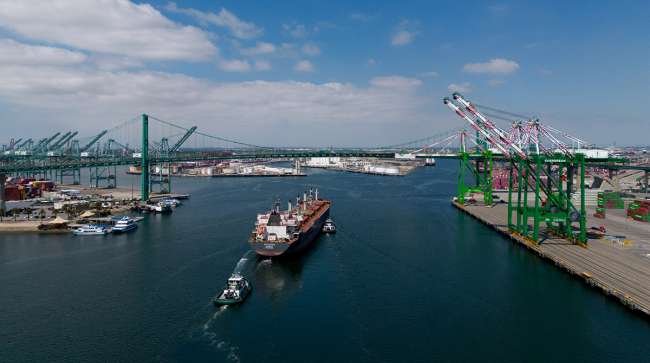A ship arrives at the Port of Los Angeles in April. (Eric Thayer/Bloomberg)
The U.S. trade deficit widened to a record in March as companies rushed to import products as the Trump administration readied sweeping tariffs.
The goods and services trade gap grew 14% from the prior month to $140.5 billion, Commerce Department data showed May 6. The median estimate in a Bloomberg survey of economists was for a $137.2 billion deficit.
The value of imports jumped 4.4% to a record $419 billion, while exports edged up just 0.2%. The figures aren’t adjusted for inflation.
Imports of consumer goods climbed by the most on record, while inbound shipments of capital equipment and motor vehicles also increased.
The trade deficit continued to increase in the past month as imports surged ahead of tariffs. pic.twitter.com/LMxPy7y6QR
— Kathy Jones (@KathyJones) May 6, 2025
The report illustrates what was likely the final push by U.S. companies to secure goods before President Donald Trump announced expansive duties on April 2. The dramatic widening of the trade deficit in the first quarter was the key reason the economy contracted for the first time since 2022.
Gross domestic product fell an annualized 0.3% in the January-March period, with net exports subtracting nearly 5 percentage points — the most on record.
However, Bloomberg Economics sees the import surge from tariff front-running easing, based on a drop in container shipping from China to the U.S. since April 16. As the trade deficit narrows, it will probably support a near-term rebound in economic growth.
Survey data from the Institute for Supply Management showing declining imports by manufacturers and services providers also suggest the strategy of rushing in imports ahead of tariffs is drawing to a close.
Trump is seeking fairness in bilateral commerce, with the aim of encouraging foreign investment in the U.S. , bolstering domestic production and shoring up national industrial security. He also see duties as a means to raise revenue for the government.
The March report showed the merchandise-trade shortfall with Canada narrowed on a seasonally adjusted basis, while the deficit with Mexico remained near the record reached in February. The gap with Ireland surged to $29.3 billion. The goods-trade deficit with China shrank.






